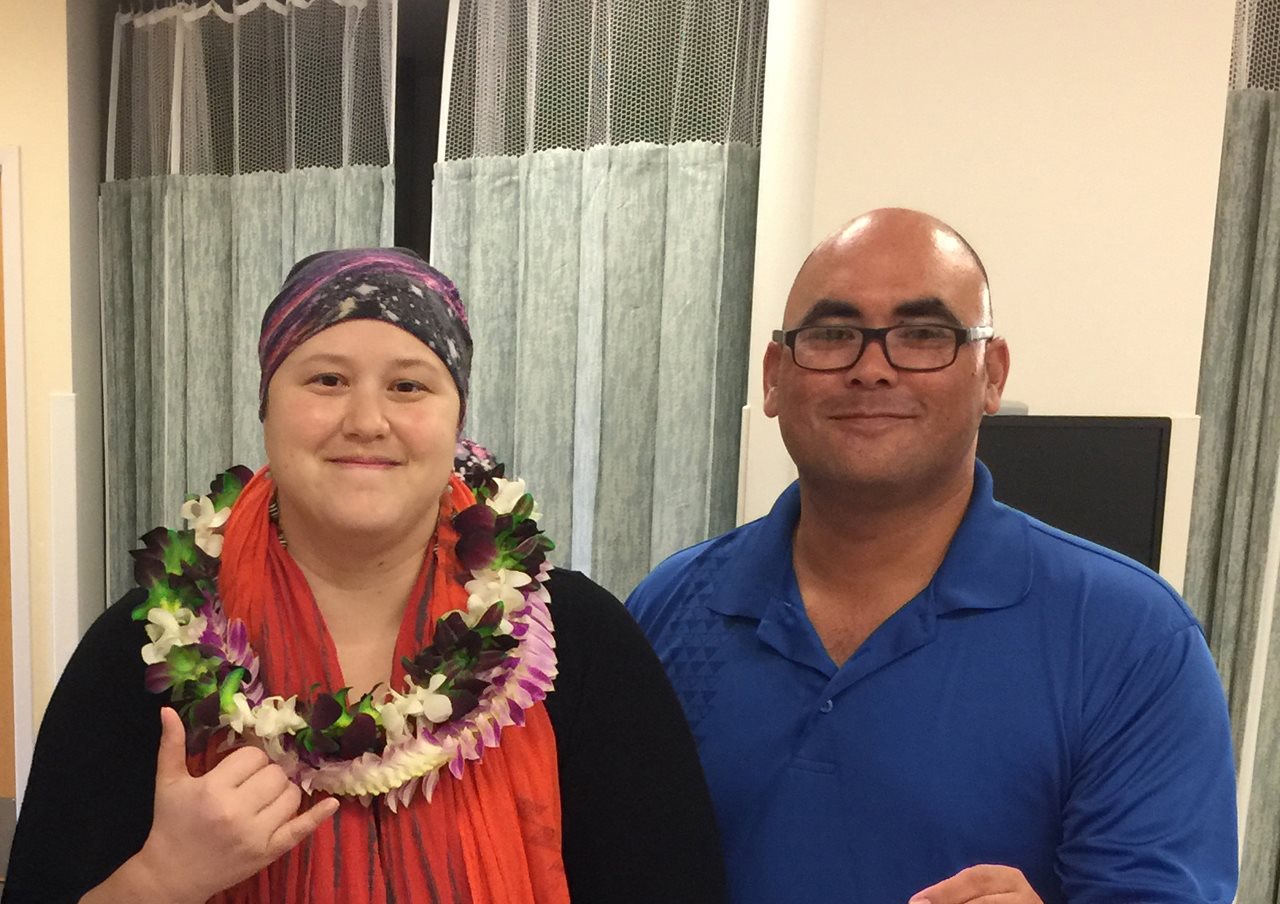2023-12-07T10:03:00
(BPT) – In August 2017, Sarah and her family had plans to join relatives in Arizona for a fun-filled few days of off-roading and watching the solar eclipse. The Monday before she left, Sarah woke up in the middle of the night with nearly uncontrollable rigors (also known as shaking chills) and was barely able to walk. She felt better – although fatigued – the next day, but after two more similar episodes, Sarah went to urgent care, hoping for answers to what was going on. Sarah was diagnosed with a urinary tract infection, and, after receiving an ultrasound and a prescription for antibiotics, Sarah and her family drove to Arizona for their vacation, completely unaware that there may be a more serious problem with her health.
“The doctor started calling just as we crossed over the border into Arizona, leaving messages and repeatedly calling back,” Sarah recalled. “When we got to our destination, we called with my entire family in the room. The doctor said I needed to get to the hospital immediately. We asked if we could go after we saw the eclipse, and the doctor said, ‘No – she won’t live that long.’”
Rushing back to the hospital, the doctor told Sarah that her ureter, the duct connecting the bladder and kidneys, had collapsed, she had sepsis (an infection of the bloodstream that may occur as a complication of an infection) and she needed emergency surgery to have a stent put in immediately. Sarah underwent surgery and over the next several months, she continued to receive antibiotics. That December, Sarah met with the head of the hospital’s urology department and an oncologist who informed her that she had transitional cell carcinoma, also known as urothelial cancer – the most common type of bladder cancer.
ABOUT BLADDER CANCER
Bladder cancer primarily affects older people. In fact, approximately nine out of 10 people with this type of cancer are over the age of 55, and the average age of diagnosis is 73 years.[1] In 2023, there were approximately 82,290 new cases of bladder cancer and approximately 16,710 deaths estimated to be reported in the U.S.[2] It is the fourth most common cancer among men in the U.S. and for men, the likelihood for developing bladder cancer during their life is about 1 in 27.[1] For women, the probability of developing bladder cancer during their life is lower at about 1 in 89.[1] Urothelial cancer, or cancer that occurs within the urothelial cells, which line the urethra, bladder, ureters, and renal pelvis, accounts for about 90% of bladder cancers.[3] In addition to its cell type, bladder cancer may be described as non-muscle-invasive or muscle-invasive.[3] If bladder cancer has spread to surrounding organs or tissues, it is called locally advanced disease. If the cancer has spread to other parts of the body, it is called metastatic disease.[3]
BLADDER CANCER SYMPTOMS
Bladder cancer is a disease in which cells within the bladder begin to grow out of control, form a tumor and, with time, may spread to other parts of the body.[4] It is often associated with urinary symptoms and other symptoms that can negatively impact a person’s quality of life.[5] Oftentimes, bladder cancer can be diagnosed early because symptoms like blood in the urine, changes in bladder habits or symptoms of irritation may prompt a person to consult their healthcare provider.[5] In some cases though, the symptoms may mirror other conditions – such as the urinary tract infection Sarah was originally diagnosed with – which can delay a bladder cancer diagnosis.[5]
Many people living with bladder cancer experience symptoms that include:[5]
- blood in the urine
- changes in bladder habits, such as having to urinate more often than usual
- pain or burning during urination
- feeling as if you need to urinate right away, even when your bladder isn’t full
- having trouble urinating or having a weak urine stream
- or having to get up to urinate many times during the night
Other people experience symptoms such as pain, tiredness, loss of appetite or weight loss.[5]
SARAH’S TREATMENT JOURNEY
Sarah was initially treated with chemotherapy. By June 2018, the cancer had spread, and surgeons eventually needed to remove her ureter, one kidney and 17 lymph nodes.
“After the surgery, I thought I was doing great. I really thought I was getting a lot better, but I started noticing that I was a little short of breath and still had some fatigue,” Sarah noted.
Through routine follow up, her doctors discovered that Sarah had a small nodule on her lung. A biopsy revealed that the nodule was malignant and that the cancer had continued to spread.
Leaning on her husband, a minister, and her faith, as well as adopting “Fight On!” – the official fight song of her favorite football team, the University of Southern California Trojans – as her mantra, Sarah decided that she “was going to choose life, and I was going to fight on.”
Following her doctor’s recommendation, Sarah joined a clinical study investigating the safety and effectiveness of a treatment called PADCEV® (enfortumab vedotin-ejfv) in combination with an immunotherapy drug. PADCEV is a medication known as an antibody-drug conjugate or ADC that works by delivering cell-killing medicine directly to certain cancer cells.[6] PADCEV may be used with pembrolizumab (Keytruda®) for adults with advanced bladder cancer who are not able to receive a chemotherapy that contains the medicine cisplatin. PADCEV with pembrolizumab was FDA approved based on a clinical study that measured how many people had a tumor response. There is another study of PADCEV with pembrolizumab to confirm this clinical benefit. PADCEV may also be used as monotherapy for adults with advanced bladder cancer who have received an immunotherapy medicine and chemotherapy that contains platinum, or who are not able to receive a chemotherapy that contains the medicine cisplatin and have received one or more prior therapies.[7]
PADCEV may cause serious side effects including skin reactions. Severe skin reactions have happened in people treated with PADCEV, and in some cases, severe skin reactions have caused death. Most severe skin reactions occurred during the first cycle of treatment but may happen later. People who are treated with PADCEV will be monitored during treatment by their healthcare providers who may stop their treatment with PADCEV completely or for a period of time (temporarily), or may change their dose, or prescribe medicines if they get skin reactions. Please see Important Safety Information below and read the Patient Information for more information, including risk of Serious Side Effects.
After Sarah enrolled in the clinical trial and began treatment with PADCEV and pembrolizumab, she was often fatigued and developed a severe rash, particularly on her legs and feet. She was on the treatment for a total of 14 months.
In a clinical trial of 121 adults treated with PADCEV in combination with pembrolizumab, who were previously untreated and could not receive cisplatin-containing chemotherapy, 55% of patients had a partial response, meaning that their tumors shrank, and 12% of patients had a complete response, meaning their tumors disappeared.[7] Individual results may vary.
Now, more than a year after completing treatment with PADCEV in combination with pembrolizumab, Sarah’s cancer is in remission. Her fatigue has resolved, however, she still deals with skin issues, and experiences weakness, numbness, pain and muscle loss in her hands and feet. Despite it all, Sarah remains grateful for the support of her church, her family and her entire community who have rallied around her during this difficult time.
“My message to other people going through a similar experience is ‘don’t let cancer define you, and don’t be afraid of it,’” Sarah says. “I really believe you can face cancer – don’t see yourself as a victim. All you have is today. I want to end each day saying, I have no regrets for this day that I’ve lived today.”
Cancer has impacted Sarah’s life in many ways, including limiting her ability to participate in some activities she previously enjoyed. She still loves to go off-roading, but these days she and her husband opt for the gentler roads. Sarah recalls, “Before I had cancer, our kids told us that I was more active than they were. After the cancer, I’m happy to say that I don’t think I’ve slowed down a whole lot.”
Sarah was compensated by Astellas and Seagen to share her story. This was her experience at the time of publication. Please see Important Safety Information below and read the Patient Information for more information, including risk of Serious Side Effects.
If you or someone you love has bladder cancer, visit https://padcev.com/ for more information, resources and support.
IMPORTANT SAFETY INFORMATION
What is the most important information I should know about PADCEV?
PADCEV may cause serious side effects, including:
Skin reactions. Skin reactions including severe skin reactions have happened in people treated with PADCEV and may be more common when PADCEV is given with pembrolizumab. In some cases, these severe skin reactions have caused death. Most severe skin reactions occurred during the first cycle of treatment but may happen later. Your healthcare provider will monitor you, may stop your treatment with PADCEV completely or for a period of time (temporarily), may change your dose, and may prescribe medicines if you get skin reactions. Tell your healthcare provider right away if you develop any of these signs of a new or worsening skin reaction:
- target lesions (skin reactions that look like rings)
- rash or itching that continues to get worse
- blistering or peeling of the skin
|
- painful sores or ulcers in mouth or nose, throat, or genital area
- fever or flu-like symptoms
- swollen lymph nodes
|
See “What are the possible side effects of PADCEV?” for more information about side effects.
Before receiving PADCEV, tell your healthcare provider about all of your medical conditions, including if you:
- are currently experiencing numbness or tingling in your hands or feet.
- have a history of high blood sugar or diabetes.
- have liver problems.
- are pregnant or plan to become pregnant. PADCEV can harm your unborn baby. Tell your healthcare provider right away if you become pregnant or think you may be pregnant during treatment with PADCEV.
- are breastfeeding or plan to breastfeed. It is not known if PADCEV passes into your breast milk. Do not breastfeed during treatment and for at least 3 weeks after the last dose of PADCEV.
Females who are able to become pregnant:
- Your healthcare provider should do a pregnancy test before you start treatment with PADCEV.
- You should use an effective method of birth control during your treatment and for at least 2 months after the last dose of PADCEV.
Males with a female sexual partner who is able to become pregnant:
- If your female partner is pregnant, PADCEV can harm the unborn baby.
- You should use an effective method of birth control during your treatment and for at least 4 months after the last dose of PADCEV.
Tell your healthcare provider about all the medicines you take, including prescription and over-the-counter medicines, vitamins, and herbal supplements. Taking PADCEV with certain other medicines may cause side effects.
What are the possible side effects of PADCEV?
PADCEV may cause serious side effects, including:
- Skin Reactions. See “What is the most important information I should know about PADCEV?”
- High blood sugar (hyperglycemia). An increase in blood sugar is common during treatment with PADCEV. Severe high blood sugar, a serious condition called diabetic ketoacidosis (DKA), and death have happened in people with and without diabetes treated with PADCEV. Tell your healthcare provider right away if you have any symptoms of high blood sugar, including: frequent urination, increased thirst, blurred vision, confusion, it becomes harder to control your blood sugar, drowsiness, loss of appetite, fruity smell on your breath, nausea, vomiting, or stomach pain.
- Lung problems. PADCEV may cause severe or life-threatening inflammation of the lungs that can lead to death. These severe problems may happen more often when PADCEV is given in combination with pembrolizumab. Tell your healthcare provider right away if you get new or worsening symptoms, including trouble breathing, shortness of breath, or cough.
- Nerve problems. Nerve problems called peripheral neuropathy are common during treatment with PADCEV and can sometimes be severe. Nerve problems may happen more often when PADCEV is given in combination with pembrolizumab. Tell your healthcare provider right away if you get new or worsening numbness or tingling in your hands or feet or muscle weakness.
- Eye problems. Certain eye problems are common during treatment with PADCEV. Tell your healthcare provider right away if you have dry eyes, increased tearing, blurred vision, or any vision changes. You may use artificial tear substitutes to help prevent or treat dry eyes.
- Leakage of PADCEV out of your vein into the tissues around your infusion site (extravasation). If PADCEV leaks from the injection site or the vein into the nearby skin and tissues, it could cause an infusion site reaction. These reactions can happen right after you receive an infusion, but sometimes may happen days after your infusion. Tell your healthcare provider or get medical help right away if you notice any redness, swelling, itching, blister, peeling skin or discomfort at the infusion site.
Your healthcare provider may decrease your dose of PADCEV, or temporarily or completely stop your treatment with PADCEV if you have severe side effects.
The most common side effects of PADCEV when used alone include:
- rash. See “What is the most important information I should know about PADCEV?”
- changes in liver and kidney function tests
- increased sugar (glucose) in the blood. See “High blood sugar (hyperglycemia)”
- tiredness
- decreased white blood cell, red blood cell, and platelet counts
|
- hair loss
- decreased appetite
- diarrhea
- decreased sodium, phosphate and protein (albumin) in the blood
- nausea
|
- itching
- change in sense of taste
- increased uric acid in the blood
- increased lipase (a blood test done to check your pancreas)
- decreased weight
- dry skin
|
If your healthcare provider prescribes PADCEV in combination with pembrolizumab for you, also read the Medication Guide that comes with pembrolizumab for important information about pembrolizumab.
The most common side effects of PADCEV when used in combination with pembrolizumab include:
- increased sugar (glucose) in the blood. See “High blood sugar (hyperglycemia)”
- changes in liver function and kidney function tests
- rash. See “What is the most important information I should know about PADCEV?”
- decreased red blood cell and white blood cell counts
- tiredness
- decreased sodium, phosphate and protein (albumin) in the blood
- increased lipase (a test done to check your pancreas)
|
- hair loss
- decreased weight
- diarrhea
- itching
- decreased appetite
- nausea
- change in sense of taste
- urinary tract infection
- constipation
- increased or decreased potassium
|
- increased calcium in the blood
- swelling of the arms, hands, legs and feet
- dry eye. See “Eye problems”
- dizziness
- joint aches
- dry skin
|
PADCEV may cause fertility problems in females and males, which may affect the ability to have children. Talk to your healthcare provider if you have concerns about fertility.
These are not all the possible side effects of PADCEV.
Call your doctor for medical advice about side effects. You may report side effects to the FDA at 1-800-FDA-1088 or www.fda.gov/medwatch.
WHAT IS PADCEV®?
PADCEV is a prescription medicine used to treat adults with bladder cancer and cancers of the urinary tract (renal pelvis, ureter or urethra) that has spread or cannot be removed by surgery. PADCEV may be used alone if you:
- have received an immunotherapy medicine and chemotherapy that contains platinum, or
- are not able to receive a chemotherapy that contains the medicine cisplatin and you have received 1 or more prior therapy.
PADCEV may be used with pembrolizumab (also known as Keytruda®) if you:
- are not able to receive a chemotherapy that contains the medicine cisplatin.
PADCEV with pembrolizumab was FDA-approved based on a clinical study that measured how many people had a tumor response. There is another study of PADCEV with pembrolizumab ongoing to confirm the clinical benefit.
It is not known if PADCEV is safe and effective in children.
© 2023 Astellas Pharma US, Inc. and Seagen Inc. All rights reserved. 081-2074-PM 11/23
PADCEV and the PADCEV device are registered trademarks jointly owned by Agensys, Inc., and Seagen Inc.
Keytruda® is a registered trademark of Merck Sharp & Dohme Corp., a subsidiary of Merck & Co., Inc., Rahway, NJ, USA.
- American Cancer Society. Key Statistics for Bladder Cancer (01-13-2023). https://www.cancer.org/cancer/types/bladder-cancer/about/key-statistics.html. Accessed 6-27-2023.
- Siegel RL, Miller KD, Wagle NS, Jemal A. Cancer statistics, 2023. CA Cancer J Clin 2023;73(1):17-48
- American Society of Clinical Oncology. Bladder Cancer: Introduction (12-21). https://www.cancer.net/cancer types/bladdercancer/introduction. Accessed 7-14-2023.
- American Cancer Society. What Is Bladder Cancer? (12-19-2019). https://www.cancer.org/cancer/bladder cancer/about/whatisbladdercancer.html. Accessed 9-27-2023.
- American Cancer Society. Bladder Cancer Signs and Symptoms (01-30-2019). https://www.cancer.org/cancer/types/bladder-cancer/detection-diagnosis-staging/signs-and-symptoms.html Accessed 10-20-2022.
- National Cancer Institute. NCI dictionary of cancer terms: antibody-drug conjugate. https://www.cancer.gov/publications/dictionaries/cancer-terms/def/antibody-drug-conjugate. Accessed 6-27-2023.
- PADCEV [package insert]. Northbrook, IL: Astellas Pharma US, Inc.



























